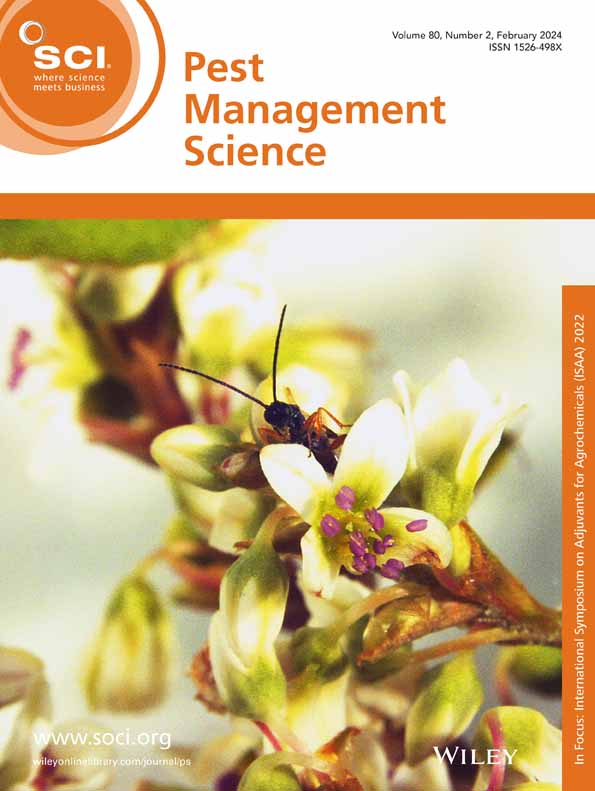地螟作为防治温室番茄灰霉病的生物防治剂载体。
IF 3.8
1区 农林科学
Q1 AGRONOMY
引用次数: 0
摘要
番茄灰霉病是番茄产量和品质的主要病害,由番茄灰霉病引起。过量使用化学杀菌剂导致了耐药菌株。由于化学杀菌剂和传统喷药的缺点,昆虫驱虫方法已成为植物保护的发展方向。本文研究了自制飞蝇蝇载体生物防制剂对番茄花期灰霉病的抑制作用。结果一项为期14天的风险评估和为期4周的慢性毒性研究表明,哈茨木霉和枯草芽孢杆菌对大黄蜂的生产和活动没有负面影响。在相同推荐田间浓度(RFC)条件下,枯草芽孢杆菌在离体水果和平板上均表现出较好的抗菌效果。结果表明,枯草芽孢杆菌可通过自制的点药器被地芽孢杆菌携带,并以平均每朵花102 ~ 103个菌落形成单位(CFU)的速度传播到花上。与对照组相比,枯草芽孢杆菌载体组平均降低了灰葡萄孢的感染率54.2%。此外,其有效性与传统喷洒方法相当,两种方法的感染率无显著差异。结论本研究表明,在开花期间,土蜂通过自制的施药器携带枯草芽孢杆菌,在不影响蜜蜂的情况下,成功地减少了灰孢杆菌的感染,达到了与传统喷洒方法相当的防病效果。这些研究结果为温室番茄灰霉病的有效和可持续管理提供了基础。©2025化学工业协会。本文章由计算机程序翻译,如有差异,请以英文原文为准。
Bombus terrestris as biocontrol agent vector to suppress Botrytis cinerea in greenhouse tomato.
BACKGROUND
Tomato gray mold, caused by Botrytis cinerea, is a major disease affecting tomato yield and quality. Excessive use of chemical fungicides has led to resistant strains. Due to the drawbacks of chemical fungicides and traditional spraying, entomovectoring methods have been developed for plant protection. Here, the potential of a biocontrol agent vectored by Bombus terrestris using a self-made flying doctor system to inhibit gray mold on tomato plants during flowering was investigated.
RESULTS
A 14-day risk assessment and a 4-week chronic toxicity study demonstrated that Trichoderma harzianum and Bacillus subtilis had no negative effects on bumblebee performance or activity. Bacillus subtilis exhibited superior antipathogen efficacy on plates and detached fruit at the same fold recommended field concentration (RFC). Consequently, it was selected for field trails, which revealed that the Bacillus subtilis could be carried by Bombus terrestris via a self-made dispenser and delivered to flowers at an average of 102 to 103 colony-forming unit (CFU) per flower. The Bacillus subtilis-vectored group reduced Botrytis cinerea infection rates by an average of 54.2% compared to the control group. Furthermore, its effectiveness was comparable to traditional spraying methods, with no significant difference in infection rates between the two approaches.
CONCLUSION
This study demonstrated that Bacillus subtilis vectored by Bombus terrestris through a self-made dispenser during flowering successfully decreased Botrytis cinerea infection without adversely impacting on bees, achieving a level of disease prevention comparable to traditional spraying methods. These findings provide a foundation for efficient and sustainable management of gray mold in greenhouse tomatoes. © 2025 Society of Chemical Industry.
求助全文
通过发布文献求助,成功后即可免费获取论文全文。
去求助
来源期刊

Pest Management Science
农林科学-昆虫学
CiteScore
7.90
自引率
9.80%
发文量
553
审稿时长
4.8 months
期刊介绍:
Pest Management Science is the international journal of research and development in crop protection and pest control. Since its launch in 1970, the journal has become the premier forum for papers on the discovery, application, and impact on the environment of products and strategies designed for pest management.
Published for SCI by John Wiley & Sons Ltd.
 求助内容:
求助内容: 应助结果提醒方式:
应助结果提醒方式:


